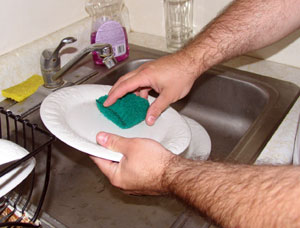 If you're like me, when you’re doing the dinner dishes you normally aren't thinking about the fate of the delta smelt, the little native fish that is one of several in steep decline and facing extinction. And yet for millions of Bay Area residents the two things--dishwashing and delta smelt--are connected. In fact, choices we make everyday on dry land--in our homes and yards, on the road, and in our schools and offices--have implications for our aquatic neighbors. The good news is, by taking some simple steps in our day-to-day lives, we can make a difference for the Bay and its watershed... and the species that live in them.
If you're like me, when you’re doing the dinner dishes you normally aren't thinking about the fate of the delta smelt, the little native fish that is one of several in steep decline and facing extinction. And yet for millions of Bay Area residents the two things--dishwashing and delta smelt--are connected. In fact, choices we make everyday on dry land--in our homes and yards, on the road, and in our schools and offices--have implications for our aquatic neighbors. The good news is, by taking some simple steps in our day-to-day lives, we can make a difference for the Bay and its watershed... and the species that live in them.
Be a smart water user
On average, Californians use about a third more water than necessary due to leaks, inefficient appliances, and overwatering. Clearly, we can do more to reduce our need to divert water from our imperiled streams and Estuary. Remember that there is an ecosystem at the other end of your tap!
Learn to monitor your household water use so you can find and repair leaks. Replace old washing machines and toilets--the biggest water users in your home--with more water efficient versions. Choose native plants better adapted to California's climate, avoid overwatering, and water in the evening or early morning when less is lost to evaporation. And don't forget to turn off the faucet when shaving, brushing teeth, or washing those dinner dishes. For many more ideas, visit the California Urban Water Conservation Council website and take the "h2ouse tour."
Don’t pollute the Bay
